Ensuring long-term health of global ecosystems
October 26, 2010
Q&A with Ann Kinzig
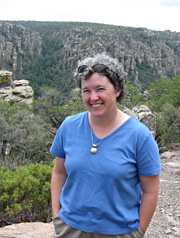
Dr. Kinzig on a research trip in Arizona’s Sky Islands region near the Mexico border.
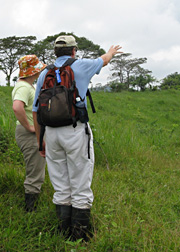
Dr. Kinzig assesses Panama ecosystems with a colleague from the Smithsonian Tropical Research Institute.
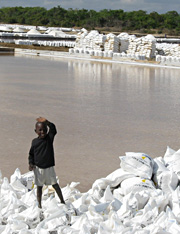
In Tanzania’s Saadani National Park, salt production coexists with ecotourism to supplement a traditional fishing economy.
Ann Kinzig is chief research strategist for the Global Institute of Sustainability, affiliated faculty in the School of Sustainability, and professor in the School of Life Sciences. In her research, she studies ecosystem services, interactions between conservation and development, and the resilience of natural resource systems. She also teaches courses in biodiversity and ecosystem services, urban ecology, current environmental issues, and undergraduate research training.
What triggered your focus on sustainability?
As a graduate student in 1989 with an M.A. degree in physics, I decided to expand my horizons. I went to work with John Holdren (now President Obama’s science advisor) at Berkeley – basically thinking systemically about society’s natural resources and energy requirements and the types of economic and political preconditions for successfully managing them. Two years later, as I was feeling increasingly drawn to the life sciences, the Ecological Society of America published their Sustainable Biosphere Initiative. This was a clarion call for me. Here, suddenly, was a field that allowed one to not only do interesting science, but also help save the world.
What are your most important sustainability-related research projects?
I am wrapping up Advancing Conservation in a Social Context, a grant with the MacArthur Foundation aimed at improving ways to identify, analyze, and negotiate the complex trade-offs between conservation and development. After five years, we can say that conservation organizations are getting better at navigating the trade-offs, but numerous challenges remain. For example, many beneficial natural systems remain undervalued, in part because we lack mechanisms for making difficult choices among different ecosystem services (some of which are delivered globally) and incorporating the value of these services into decision-making at the local level. In response, I plan to work with colleagues at Conservation International to model how ecosystem services are delivered under different policies and landscape configurations. This work builds on an ongoing collaboration between the ASU ecoServices group (faculty and students focused on international biodiversity projects) and the Smithsonian Tropical Research Institute in Panama.
How can your research affect real-world policy decisions?
Our models can tell decision-makers and managers how local policies will affect landscapes and the wider flows of ecosystem services. For example, we are currently working in the Panama Canal Watershed to model the ecosystems that provide water for the locks. If the delivery of water were substantially diminished, the world would see major consequences for global shipping and trade. Our goal is to identify the best landscape configurations for both local and global benefits.
What is the world sustainability challenge that concerns you most?
First, I am concerned about our capacity to understand and manage complex adaptive systems. We have to recognize that these systems are not linear or fully predictable and that policy decisions must be revisited as we monitor results and correct course. A second challenge is that most of our major environmental issues transcend national boundaries. We need global governance mechanisms in place to deal with this.
What are your plans as new chief research strategist for the Global Institute of Sustainability?
My goal is to launch a collective exercise among faculty to imagine what sustainability science should look like a decade from now if it is to serve society. We need to identify both the looming challenges and the gaps in meeting those challenges, and then decide which gaps we at ASU want to fill. One example may be to join our strengths in energy technologies with our knowledge about society and decision-making to improve our understanding of the potential promise and unintended consequences of next-generation energy technologies. Few places examine innovation from both a technological and social perspective, but it is essential in meeting global challenges in a timely fashion without creating new hazards.
October 26, 2010
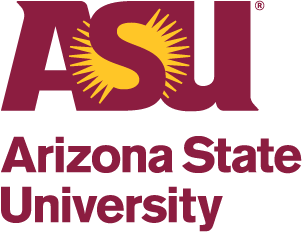

 Almost every bike rider has experienced the pain of a flat tire and the agonizing search for a way to fill it back up. Now, the ASU community will have a quicker, easier solution for their flat tires! With financial support from State Farm Insurance, ASU is installing seven air compressor stations across the university that cyclists can utilize. Four stations will be installed on the Tempe campus, and one on the Polytechnic, Downtown, and West campuses. In addition to the conventional Schrader valve used on most beach cruisers and mountain bikes, there will also be a high pressure Presta valve for road and racing bikes. The system was designed to be easy for users of any experience, with the pressure set to prevent the possibility of blowouts. Additionally, there will be a sign with instructions on how to use the air station.
Almost every bike rider has experienced the pain of a flat tire and the agonizing search for a way to fill it back up. Now, the ASU community will have a quicker, easier solution for their flat tires! With financial support from State Farm Insurance, ASU is installing seven air compressor stations across the university that cyclists can utilize. Four stations will be installed on the Tempe campus, and one on the Polytechnic, Downtown, and West campuses. In addition to the conventional Schrader valve used on most beach cruisers and mountain bikes, there will also be a high pressure Presta valve for road and racing bikes. The system was designed to be easy for users of any experience, with the pressure set to prevent the possibility of blowouts. Additionally, there will be a sign with instructions on how to use the air station.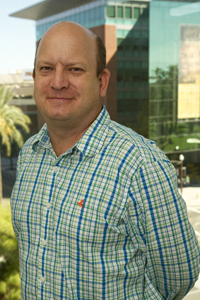
 Each August, nearly 10,000 students on the Tempe campus alone move in to their new homes with all of their boxes and bags of things. It is the first chance we have to educate residents, mostly new-to-ASU Freshmen, about the recycling practices at the university, and it is also the first major waste-generating event of the year. This year, led by Rebecca Reining of University Housing, a team was assembled with representatives also from Grounds Services, Facilities Management, University Sustainability Practices, and the Center for Student Sustainability Initiatives (CSSI) & their Green Team volunteers to coordinate and run the program, which started in early May before Move-out was even finished.
Each August, nearly 10,000 students on the Tempe campus alone move in to their new homes with all of their boxes and bags of things. It is the first chance we have to educate residents, mostly new-to-ASU Freshmen, about the recycling practices at the university, and it is also the first major waste-generating event of the year. This year, led by Rebecca Reining of University Housing, a team was assembled with representatives also from Grounds Services, Facilities Management, University Sustainability Practices, and the Center for Student Sustainability Initiatives (CSSI) & their Green Team volunteers to coordinate and run the program, which started in early May before Move-out was even finished.
 During Passport to ASU 2010 a student asked me why he should shop at a farmers market. I told him that The Tamale Store tamales are delicious, that it’s like drinking an apple when you have some Sedona Sweet Cider, and that it is a slice of heaven to eat a tomato from Big Happy Farms. This fall’s Farmers Market at the ASU Tempe campus starts on Tuesday, October 5th, and it will continue every other Tuesday (October 19, November 2, November 16 and November 30). From the
During Passport to ASU 2010 a student asked me why he should shop at a farmers market. I told him that The Tamale Store tamales are delicious, that it’s like drinking an apple when you have some Sedona Sweet Cider, and that it is a slice of heaven to eat a tomato from Big Happy Farms. This fall’s Farmers Market at the ASU Tempe campus starts on Tuesday, October 5th, and it will continue every other Tuesday (October 19, November 2, November 16 and November 30). From the  We might not have the same sleek sunglasses as Horatio Caine, but the new Center for Student Sustainability Initiatives (CSSI), or as we like to call it, “CSI: Students,” is just as cool. Resulting from the mutual merger of the Undergraduate Student Government’s Campus Environment Department and the Sustainability Initiatives Group, and in collaboration with University Sustainability Practices, CSSI is poised to be the leading student group on the Tempe campus for engaging students in projects, initiatives, and events here on our campus.
We might not have the same sleek sunglasses as Horatio Caine, but the new Center for Student Sustainability Initiatives (CSSI), or as we like to call it, “CSI: Students,” is just as cool. Resulting from the mutual merger of the Undergraduate Student Government’s Campus Environment Department and the Sustainability Initiatives Group, and in collaboration with University Sustainability Practices, CSSI is poised to be the leading student group on the Tempe campus for engaging students in projects, initiatives, and events here on our campus. One of the areas we are really excited about is developing intern/liaison positions to the various student-centric groups and departments on campus (eg, the Memorial Union, Student Recreation Center, Student Organization Resource Center, ASU Athletics, etc). This program is still in its conceptual phase, but hopefully CSSI will sponsor one or more interns/liaisons the to various departments who will assist both in greening the operations as well as promoting and marketing sustainability within the different areas in exchange for course credit.
One of the areas we are really excited about is developing intern/liaison positions to the various student-centric groups and departments on campus (eg, the Memorial Union, Student Recreation Center, Student Organization Resource Center, ASU Athletics, etc). This program is still in its conceptual phase, but hopefully CSSI will sponsor one or more interns/liaisons the to various departments who will assist both in greening the operations as well as promoting and marketing sustainability within the different areas in exchange for course credit. ASU and The Pack Shack are discovering ways to reuse old and tattered banners that would otherwise be sent to a landfill or a recycling center.
ASU and The Pack Shack are discovering ways to reuse old and tattered banners that would otherwise be sent to a landfill or a recycling center.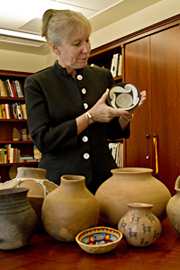
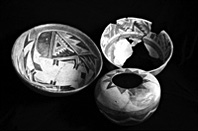
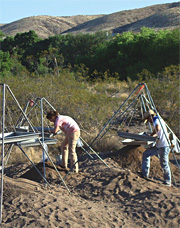
 At West, the Freshman summer reading was In Defense of Food by Michael Pollan. In a recent article in Utne Reader, he stated that “Americans have not had to think very hard about where their food comes from, or what it is doing to the planet, their bodies, and their society.” Well Mr. Pollan, your book got us thinking. A full year series of events called “Much Ado About Food” kicked-off on August 26th with the goal of educating our community about the impact of the foods we eat. Education is just the first step though. It is clear that we also need to create opportunities for our community to make lifestyle changes based upon the lessons they learn.
At West, the Freshman summer reading was In Defense of Food by Michael Pollan. In a recent article in Utne Reader, he stated that “Americans have not had to think very hard about where their food comes from, or what it is doing to the planet, their bodies, and their society.” Well Mr. Pollan, your book got us thinking. A full year series of events called “Much Ado About Food” kicked-off on August 26th with the goal of educating our community about the impact of the foods we eat. Education is just the first step though. It is clear that we also need to create opportunities for our community to make lifestyle changes based upon the lessons they learn. No, I am not referring to the poppy dance group of yesteryear; I am of course referring to the newest addition of sustainability themed clubs at ASU. Arizona State Cycling Club (ASCC) formed in March of 2010. They are a spunky, high spirited group and their numbers are growing fast. The officers gained just enough momentum to organize one meeting and one social ride last spring. They were hard at work over the summer planning a slew of bike themed meetings and fun rides for this fall. When asked what inspired him to found ASCC, School of Sustainability senior Tyler Viliborghi responded, “A few friends and I decided to spend an entire day exploring the town by bike and concluded with a picnic/feast in the park. It was such an amazing day that we decided we needed to share and protect these kinds of experiences by offering an outlet here at ASU.”
No, I am not referring to the poppy dance group of yesteryear; I am of course referring to the newest addition of sustainability themed clubs at ASU. Arizona State Cycling Club (ASCC) formed in March of 2010. They are a spunky, high spirited group and their numbers are growing fast. The officers gained just enough momentum to organize one meeting and one social ride last spring. They were hard at work over the summer planning a slew of bike themed meetings and fun rides for this fall. When asked what inspired him to found ASCC, School of Sustainability senior Tyler Viliborghi responded, “A few friends and I decided to spend an entire day exploring the town by bike and concluded with a picnic/feast in the park. It was such an amazing day that we decided we needed to share and protect these kinds of experiences by offering an outlet here at ASU.”